Understanding violence and prevention during a pandemic: California news about guns, gun violence, and firearm suicide, 2020-2021
Tuesday, October 05, 2021Gun violence and firearm suicide are preventable — but news coverage often obscures that fact: We know from decades of research that, in general, news coverage of different kinds of violence can stoke fear by focusing narrowly on the details of the most extreme cases, obscuring solutions,1, 2 and reinforcing the sense that the problem is inescapable and unchangeable.
That’s why a key component of stopping gun violence and firearm suicide in America is understanding the complete picture of these public health crises, as well as what can be done — and is being done — in communities across the country to prevent harm or support survivors of violence.
In 2020, discussions about violence, and gun violence in particular, took on new importance as the global COVID-19 pandemic spurred historic increases in gun sales3 and concerns about mental health and family violence among families and individuals in quarantine.4 Following the murder of George Floyd by Minneapolis police in the summer of 2020, nationwide protests against police brutality and structural racism put police violence and officer-involved shootings in the spotlight.5
We wanted to know:
- How have gun violence and firearm suicide appeared in California news amid the pandemic and nationwide protests about police brutality?
- How has the volume of news coverage about gun violence changed in recent years?
- What types of gun violence receive the most coverage?
At Berkeley Media Studies Group, we believe that the news provides an important window into public discourse and has a strong influence on what people and policymakers understand and how they understand it. We wanted to know: How have gun violence and firearm suicide appeared in California news amid the unprecedented events of 2020 and early 2021? And how has coverage of gun violence changed over the past several years, since our last study of this issue?
We present here a quantitative analysis of California news published between January 1, 2020 and June 30, 2021. These findings build in part on a study we released in June of 2018 titled “More Than Mass Shootings: Gun Violence Narratives in California News,”6 part of a long-term partnership between BMSG and the Hope and Heal Fund focused on examining and shifting the news narrative around gun violence and firearm suicide. That report evaluated California news about three major types of day-to-day gun violence, including firearm suicide, domestic violence incidents involving guns, and community-level violence (also known as street violence) involving guns.
Our analysis found significant gaps in the coverage, such as limited news about firearm suicide and domestic violence involving guns, and the persistent use of language and images in the news that could reinforce harmful stereotypes about communities of color, particularly young Black and Brown men. That analysis also surfaced gaps in news coverage of police-involved acts of gun violence, though that issue was not a major focus of the report.
The following analysis not only documents how often the issues from our previous analysis (gun-related suicide, domestic violence, and community violence) appeared in English- and Spanish-language news; we also expanded the scope of this study to explore gun sales and police violence in response to a surge in the number of guns in circulation7 and the Black Lives Matter movement building the largest protests in U.S. history.8
What we did
We searched the Lexis-Nexis database for print and online news published between January 1, 2020 and June 30, 2021 in 118 English- and Spanish-language California newspapers. We selected these dates to capture the impact of various gun violence incidents on the news cycle: the statewide stay-at-home order (March 19, 2020); police killing of George Floyd in Minneapolis (May 25, 2020); the attack on the U.S. Capitol by armed supporters of Donald Trump (January 6, 2021); and mass shootings in an Atlanta spa and a Boulder grocery store that took place within one week (March 16, 2021 and March 22, 2021).
To enable comparisons with our prior research, we replicated the search terms we used in our prior study to capture English-language articles about domestic violence, community violence, and suicide related to guns. We updated our previous search terms for Spanish-language articles to be more comprehensive.
We also designed new search strings to capture news about topics we didn’t explore in the previous analysis: news about gun sales, particularly among first-time buyers, and stories about police violence, including shootings and any use of deadly force. We collected these stories over the same time period and evaluated the volume of coverage these search terms would have yielded had we run them during the prior study period (October 15, 2016 to October 14, 2017).
For English-language news, we searched for keywords related to issues like racism, prevention, and community action in the lead paragraphs of stories (see Appendix 1 for a complete list of keywords). For each keyword, we searched for variations, including alternate spellings, hyphenated and singular versions (e.g., to search for “shootings,” we searched for “shooting,” “shoot,” and “shot”). We documented the number of articles that included at least one mention of a keyword in the lead paragraph. We did not conduct keyword searches in Spanish because of the low volume of coverage.
What we found
Our searches retrieved a total of 19,173 articles (English n=17,615 and Spanish n=1,558) about community or domestic violence involving guns, firearm suicide, police violence involving guns, or gun sales published in California newspapers between January 1, 2020 and June 30, 2021. Stories about police violence dominated English news, while Spanish-language news mostly focused on community-level violence (see Figure 1).
FIGURE 1: News articles about gun-related community violence, domestic violence, suicide, police violence, and gun sales in California newspapers, January 1, 2020 – June 30, 2021
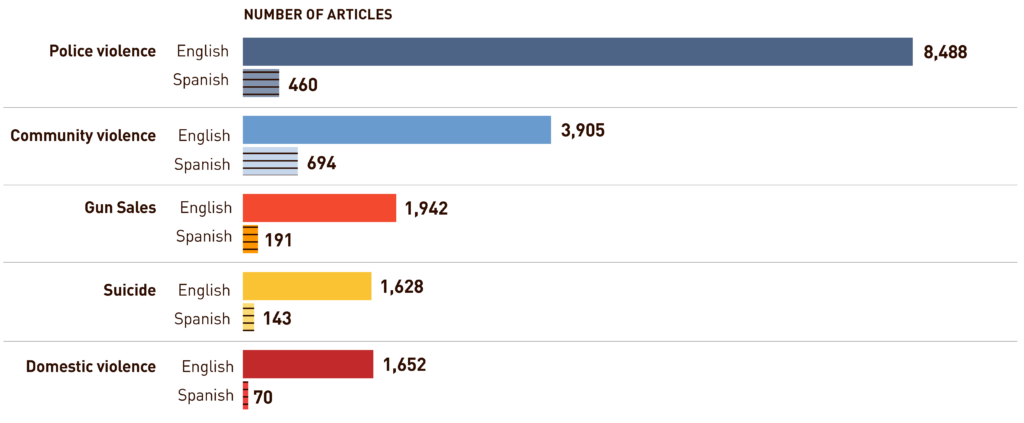
We compared the volume of news coverage to our previous analyses.
News coverage of community violence, domestic violence, and suicide in California newspapers was higher in 2020-21 compared to 2016-17: Between January 1, 2020 and June 30, 2021, we found 8,092 articles about gun-related community violence, domestic violence, or suicide — an average of 450 stories per month, compared to an average of 318 stories per month during the sample period of the previous study (see Figure 2).
FIGURE 2: Average number of stories per month covering gun-related community violence, domestic violence, suicide, police violence, and gun sales (2016-2017 vs. 2020-2021)
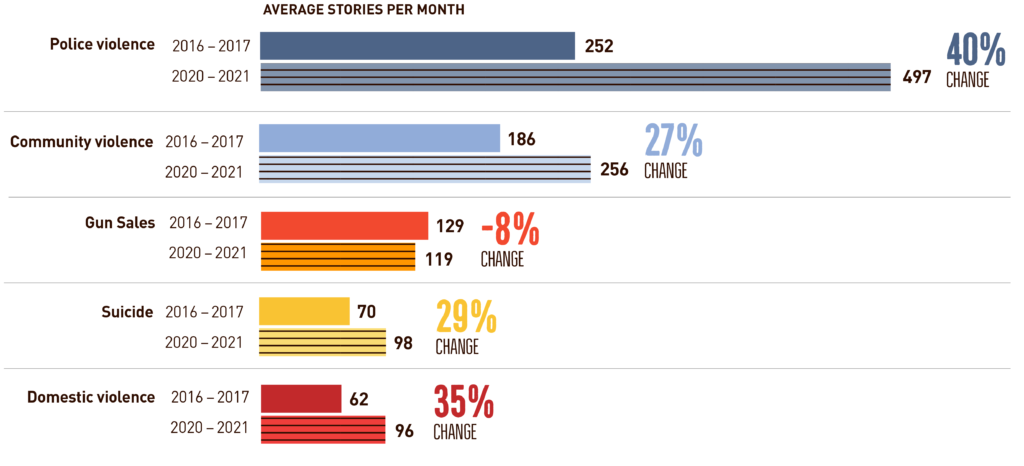
The results of retrospective searches for news about police violence and gun sales show that the combined volume of coverage for these topics increased as well. News about police violence accounts for most of this increase; news about gun sales remained relatively stable across time periods, perhaps because both studies included election years when coverage of gun sales was elevated.9,10
News related to gun violence made up about 2% of all English- and Spanish-language news stories published during 2020-21 (see Figure 3). From 2016-17 to 2020-21, Spanish-language news increased by 60%, while English-language news increased by 25%.
FIGURE 3: Volume of articles related to gun violence compared to total volume of news in California newspapers, October 15, 2016 – October 14, 2017 and January 1, 2020 – June 30, 2021

English-language news about guns was published around the state.
Most gun-related news stories were concentrated in California’s top outlets: The East Bay Times (2,327 articles), The Mercury News (2,212 articles), San Francisco Chronicle (1,712 articles), Los Angeles Times (1,037 articles), The San Diego Union-Tribune (592 articles), and The Sacramento Bee (520 articles). However, there was robust local coverage throughout the state (see Figure 4). Most Spanish-language news came from one outlet in Southern California: La Opinión (97% of 1,558 Spanish-language stories).
FIGURE 4: Top 10 local English-language news outlets in California covering gun-related community violence, domestic violence, suicide, police violence, and gun sales, with exclusions*
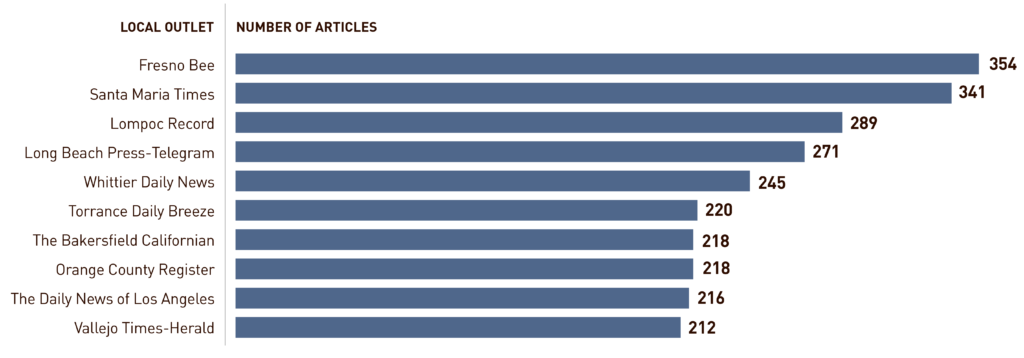
One in 10 English-language news stories mentioned prevention.
After conducting our keyword search across English-language news, we found that approximately one in 10 stories included some reference to “prevention” in the lead paragraph (11% of articles); in our previous analysis, only 3% of articles mentioned prevention. “Accountability” appeared in 5% and “justice” appeared in 3% of leads.
Guns and domestic violence and firearm suicide rarely appeared in the news.
As we observed in our previous analysis, the volume of news about community violence dwarfed news about domestic violence or suicide in both English- and Spanish-language news. Between January 1, 2020 and June 30, 2021, there were 4,599 articles about community violence, but only 1,771 articles about suicide, and 1,722 articles about domestic violence (see Figure 5).
A qualitative analysis of headlines showed that news about community violence peaked in April 2021, as communities braced for protests and reactions to the Derek Chauvin trial verdict for the murder of George Floyd.9 Domestic violence news peaked in January 2021 because of reports of surges in gun-related homicides10 and increases in domestic violence incidents.11 News about firearm suicide peaked in April 2021 when President Biden addressed the issue as part of new gun control actions.12
FIGURE 5: All articles about guns related to community violence, domestic violence, and suicide in California newspapers, January 1, 2020 – June 30, 2021 (English n=7,185 and Spanish n=907)
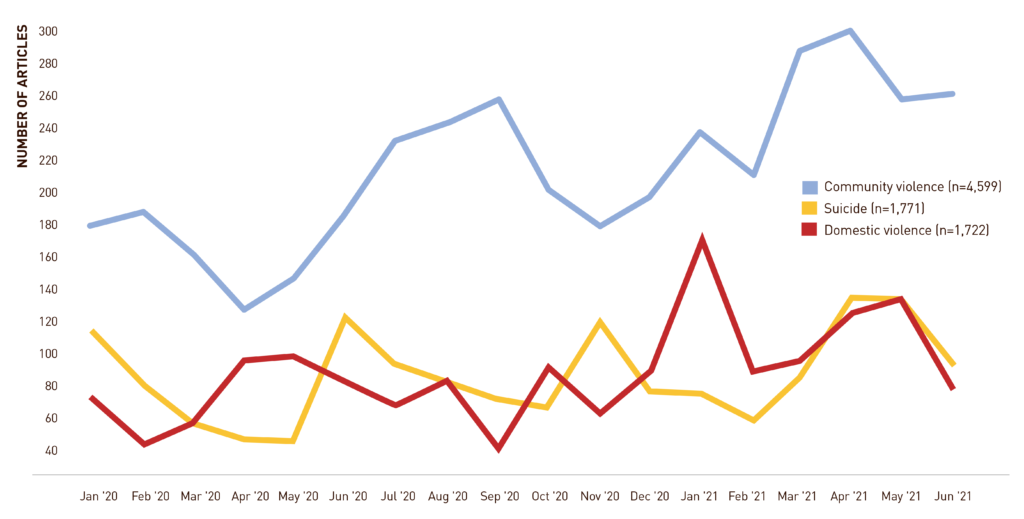
California news about police violence notably increased and peaked during the summer of 2020.
We found 8,948 articles about police violence, police shootings, and the use of deadly force by police published during the study period — by far the highest volume of any topic. News about police violence peaked in June 2020 after the murder of George Floyd, when coverage increased nearly sixfold compared to prior months: This month alone accounted for nearly one-quarter of all police violence news. Coverage of police violence and deadly force then fell by two-thirds in the months following Floyd’s murder, though it peaked again in April 2021 during the trial of former police officer Derek Chauvin, who became the first white officer to be convicted of the murder of a Black person in Minnesota.13
FIGURE 6: News articles about police violence in California newspapers, January 1, 2020 – June 30, 2021 (English n=8,488 and Spanish n=460)
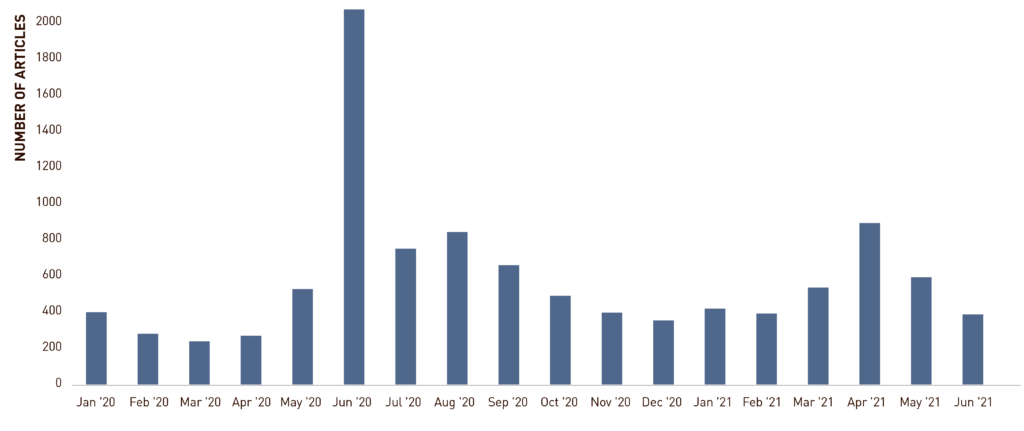
Though our analysis focused on all types of police violence and use of deadly force, two-thirds of stories about police violence (67%) used the term “shooting” in the lead paragraph. Additionally, 59% of stories mentioned “killings” in the lead paragraph, 50% mentioned “force” (most commonly described as “excessive,” rather than “deadly” or “lethal”), and 28% mentioned “murder.” Only 7% of articles mentioned “officer-involved shooting” or “police-involved shooting” — a phrase used by police to “obscure accountability and basic clarity.”14
We also explored how community actions in response to police violence were characterized in California news. As we found in a separate analysis,15 the kind of language reporters use to describe community-led actions have important implications for their framing — whether they are deemed legitimate or disruptive, peaceful or violent, etc. In the current study, we found that 42% of articles mentioned “protests” in the lead paragraph, while 15% mentioned “demonstrations,” 12% described “riots,” and 8% used the term “looting.”
We evaluated whether the news included calls to action, references to solutions, or demands for accountability of police officers and changes to the law enforcement system. Specifically, we focused on calls to reform, defund, or abolish the police: 20% of articles mentioned “reform,” 9% mentioned “defund,” and just 2% used any variation of the phrase “abolish.”
Given the disproportionate impact of police violence on Black, Indigenous, and people of color, we explored how racism appeared in stories. We found that 25% of lead paragraphs mentioned “racism,” while less than 1% mentioned “white supremacy.”
Coverage of gun sales was similar to previous years and paralleled trends in news about firearm suicide.
We found 2,133 articles about gun sales during our study period, almost one-third of which explicitly referenced the pandemic in the lead paragraph (29% of articles). Coverage of gun sales peaked in March 2020, likely due to the COVID-19 pandemic and stay-home orders. News peaked again because of election season (October 2020), back-to-back mass shootings (March 2021), and the controversial overturn of the California state ban on assault weapons (June 2021).
FIGURE 7: News articles about gun sales in California newspapers, January 1, 2020 – June 30, 2021 (English n=1,942 and Spanish n=191)
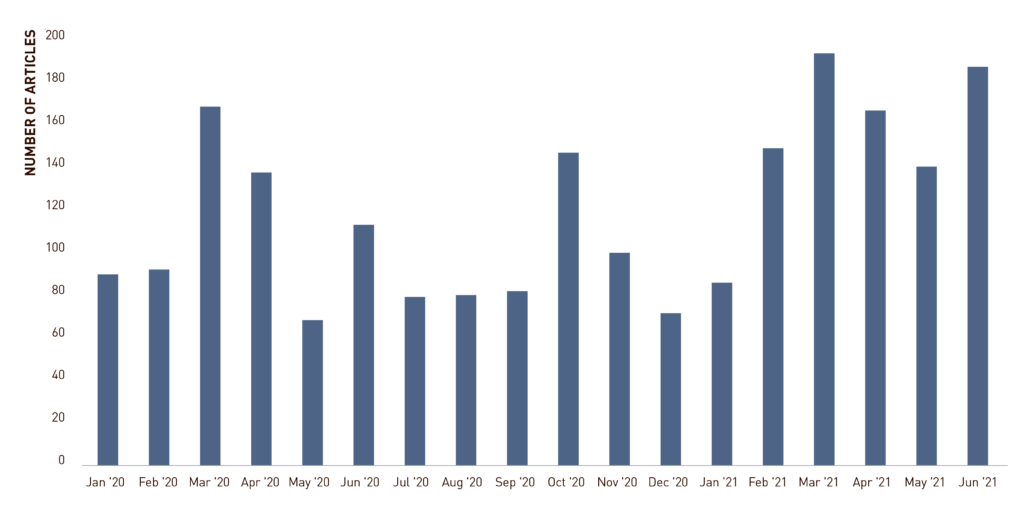
Research has documented an uptick in first-time gun ownership among people of color.16 We wondered whether this shift was reflected in the news — that is, whether news stories focused on gun purchases by white males17 or if Black, Indigenous, and people of color were also mentioned in stories about buying guns. Almost one-third of stories about gun sales in California explicitly mentioned Black or African-American gun buyers in the lead paragraph. By contrast, white buyers were mentioned in 21% of lead paragraphs. Only 9% of lead paragraphs mentioned Latino buyers, 4% mentioned Asian purchasers, and just 1% mentioned Hispanic or Spanish-speaking people.
We also observed striking parallels between coverage of gun sales and coverage of firearm suicide. Across the study period, peaks in news about gun sales were closely followed by peaks in news about gun-related suicide, most visibly seen in March/June 2020, October/November 2020, and March/April 2021.
FIGURE 8: News articles about gun sales (n=2,133) and gun-related suicide (n=1,771) in California newspapers, January 1, 2020 – June 30, 2021

Conclusion
Our analysis of California news about gun-related violence and gun sales showed that:
- Coverage of firearm suicide and all forms of gun violence in California news has increased since our previous analysis.
- Sensational or high-profile events continue to spur peaks in coverage of gun violence, followed by declines. These patterns could mask trends in day-to-day gun violence and firearm suicide.
- Stories about police violence dominated English-language news and peaked amid national protests in the summer of 2020 following the murder of George Floyd. However, coverage quickly returned to baseline levels in the following months.
- There was significantly less Spanish- than English-language news about gun violence, police violence, and gun sales, almost all of which came from one outlet. Our findings align with research documenting declining circulation in Spanish-language print media in the U.S.,18 as well as Latinx communities’ growing use of social media19 and messaging apps20 for news.
- Despite record numbers of first-time firearm purchases, coverage of gun sales did not markedly increase since our previous analysis, possibly because both analysis periods included presidential elections, when gun sales — and potentially related news coverage — tend to spike.21
Recommendations for advocates
Monitor the media.
Be aware of when gun violence is — and isn’t — in the news, how it is framed, who is quoted, and whether and how solutions and community action appear in the coverage. Tools like Google Alerts, newsletters, or email alerts from local outlets can help you stay abreast of news about gun violence, gun sales, firearm suicide, and related issues in your community and beyond. Remember to monitor English- and Spanish-language media if Spanish-language outlets are important for your work and your community. In addition to print news, consider monitoring social media outlets, radio, and television.
Be prepared to piggyback off breaking news.
Journalists continually report on issues related to guns. As a result, there are many opportunities to pitch stories or contribute opinion pieces that “piggyback” off of attention to guns. Piggybacking is a way for advocates to add more context about the causes of gun violence in their own communities, highlight ways to prevent violence before it starts, and expand the frame to elevate equitable, community-led solutions.
Build relationships with reporters.
Advocates can become trusted sources for reporters when they build long-term relationships. When journalists are aware of you, your work, and your networks, it will be easier to pitch them opinion pieces or news stories that broaden the frame around gun violence. They will also be more likely to turn to you as a source when they need to report on stories about gun violence and firearm suicide. Remember to connect with Spanish-language reporters if their outlets are important for your work. Think about social media, radio, and TV outlets, especially if print outlets are limited.
Changing the discourse around violence can seem overwhelming, but as the country grapples with difficult conversations about race, violence, and community against the backdrop of the ongoing pandemic, the public narrative around these issues is in flux. We know that community residents, public health practitioners, and others are working to shift the discourse in California toward narratives that elevate prevention, multisector partnerships, and community leadership rooted in principles of racial equity. We hope that these updated findings provide valuable information about the news landscape that can support and inform these leaders in their efforts to make every community healthier, safer, and more just.
Acknowledgments
This report was written by Kim Garcia, Sarah Perez-Sanz, Pamela Mejia, and Lori Dorfman, with guidance and input from Brian Malte, Cuco Rodriguez, Mary Kopp, and Ally Barron. We thank Jen Brower and Heather Gehlert for their support in design and copy editing. Thanks also to Diana Guardado for her thoughtful insights.
Appendix
| List of keywords for lead paragraph searches | |||
|---|---|---|---|
| officer-involved shooting, police-involved shooting | protest | domestic violence | accountability |
| officer shooting, police shooting | demonstration | people of color | save/saving lives |
| shooting, shoot, shot | riot | communities of color | data-driven strategy |
| lethal force | looting | Black | data driven, data-driven |
| deadly force | kill | African American | data |
| excessive force | abuse | Hispanic | strategy |
| deadly police | murder | Latino | stopping shootings |
| police violence | deadly | Indigenous | reduction in gun homicide |
| police brutality | hate crime | Native | gun homicide |
| police violence AND brutality | pandemic | Asian | cost-effective, cost effective |
| gun, firearm | panic | Pacific Islander | catalyst to reduce gun violence |
| defund | first time, first-time | white | catalyst |
| reform | suicide | white supremac* | invest in gun violence prevention |
| abolish | militia | justice | invest |
| racism | mental health | violence reduc* | prevention |
| Spanish | |||
References
1 McManus J., & Dorfman L. (2000, April 1). Issue 9: Youth and violence in California newspapers. Retrieved from Berkeley Media Studies Group website: http://www.bmsg.org/resources/publications/issue-9-youth-and-violence-in-california-newspapers.
2 McManus J., & Dorfman L. (2002). Youth violence stories focus on events, not causes. Newspaper Research Journal; 23(4): 6–12
3 Gun Violence and COVID-19 in 2020: A year of colliding crises (2020, May 7). Retrieved from Everytown Research & Policy website: https://everytownresearch.org/report/gun-violence-and-covid-19-in-2020-a-year-of-colliding-crises/.
4 Evans M., Lindhauer M., & Farrell M. (2020, December 10). A Pandemic within a Pandemic — Intimate Partner Violence during Covid-19. New England Journal of Medicine. Retrieved from https://www.nejm.org/doi/full/10.1056/NEJMp2024046.
5 Karnowski, S. (2020, June 30). Court OKs 3rd-degree murder against 3-ex cops in Floyd death. The Associated Press. Retrieved from https://apnews.com/article/mn-state-wire-death-of-george-floyd-2ccad4d876d39044eda79402353b6819. June 30, 2020.
6 Marvel, D., Mejia, P., Nixon, L., & Dorfman, L. Issue 25: More than mass shootings: Gun violence narratives in California. (2018, June 18.) Retrieved from Berkeley Media Studies Group website: http://www.bmsg.org/resources/publications/gun-suicide-community-domestic-violence-news-narratives-california/.
7 Hatchimonji J.S., Swendiman R.A., Seamon M.J., & Nance M.L. (2020, August). Trauma Does not Quarantine: Violence During the COVID-19 Pandemic. Annals of Surgery. Retrieved from https://www.ncbi.nlm.nih.gov/pmc/articles/PMC7224619/.
8 Buchanan L., Quoctrung B., & Patel J.K. Black Lives Matter may be the largest movement in U.S. history, (2020, July 3). The New York Times. Retrieved from https://www.nytimes.com/interactive/2020/07/03/us/george-floyd-protests-crowd-size.html.
9 Rector K. (2021, April 19). A high-stakes moment for LAPD as city braces for verdict in Derek Chauvin trial. Los Angeles Times. Retrieved from https://www.latimes.com/california/story/2021-04-19/lapd-mulling-protest-posture-at-pivotal-moment-in-national-debate.
10 Blume H. (2021, January 16). LAPD chief calls out deadly crime surge. Los Angeles Times. Retrieved from https://www.latimes.com/california/story/2021-01-16/lapd-chief-calls-out-deadly-crime-surge.
11 Louie D. (2021, January 18). Lockdown split: Bay Area sees spike in divorce filings, domestic abuse cases amid pandemic. ABC7 News. Retrieved from https://abc7news.com/divorce-during-covid-bay-area-rate-how-to-file/9787902/.
12 Christopher B. (2021, April 9). Guns, fire and mule parades. CalMatters. Retrieved from https://calmatters.org/newsletters/whatmatters/2021/04/biden-california-gun-control/.
13 Orrick D. (2021, April 20). Derek Chauvin verdict: Murder conviction of white cop killing a Black suspect is rare. Pioneer Press. Retrieved from https://www.twincities.com/2021/04/20/derek-chauvin-trial-murder-conviction-of-white-cop-killing-a-black-suspect-would-be-rare/.
14 Allsop J. (2021, April 13). Daunte Wright, George Floyd, and a renewed focus on police brutality. Columbia Journalism Review. Retrieved from https://www.cjr.org/the_media_today/daunte_wright_george_floyd_minneapolis.php.
15 Mejia P. (2021, January 8). Protest? Riot? Insurrection? Examining the news from January 6 — and where journalism goes from here. Retrieved from Berkeley Media Studies Group website: http://www.bmsg.org/blog/protest-riot-insurrection-examining-the-news-from-january-6-and-where-journalism-goes-from-here/.
16 Curcuruto J. (2020, July 21). NSSF survey reveals broad demographic appeal for firearm purchases during sales surge of 2020, National Shooting Sports Foundation. Retrieved from https://www.nssf.org/articles/nssf-survey-reveals-broad-demographic-appeal-for-firearm-purchases-during-sales-surge-of-2020/.
17 Firearm ownership in California: Results from the 2018 California Safety and Wellbeing Survey (CSaWS), University of California Firearm Violence Research Center. Retrieved from https://health.ucdavis.edu/vprp/UCFC/Fact_Sheets/CSaWSBrief_InjPrev_Kravitz-Wirtz.pdf.
18 Retis J. (2019, May 13). Hispanic media today. Democracy Fund. Retrieved from https://democracyfund.org/idea/hispanic-media-today-2/.
19 Ghaffary S. (2020, November 19). How fake news aimed at Latinos thrives on social media. Vox. Retrieved from https://www.vox.com/recode/21574293/social-media-latino-voters-2020-election.
20 Kozlowska H. (2018, March 2). Hispanics use WhatsApp more than any other ethnic or racial group in the US. Quartz. Retrieved from https://qz.com/1220212/hispanics-use-whatsapp-more-than-any-other-ethnic-or-racial-group-in-the-us/.
21 Tavernise S. (2021, May 29). An arms race in America: Gun buying spiked during the pandemic. It’s Still Up. The New York Times. Retrieved from https://www.nytimes.com/2021/05/29/us/gun-purchases-ownership-pandemic.html.




